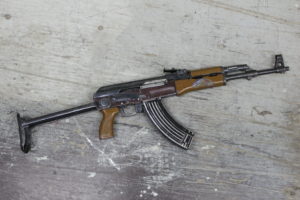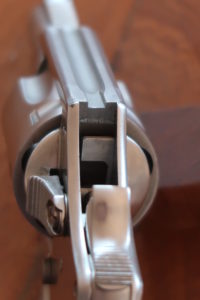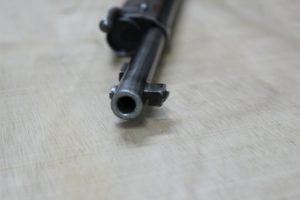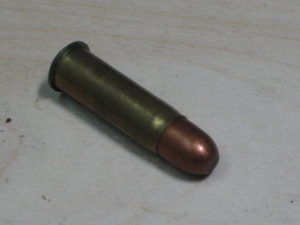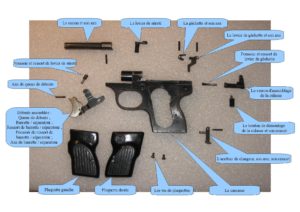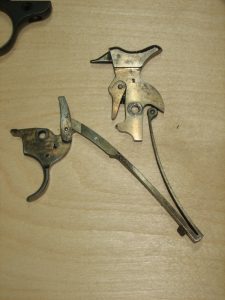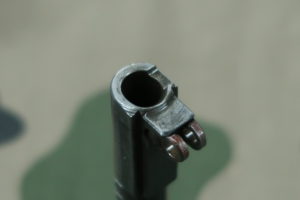Through the retranscription of an article punctuated by an ounce of optimism published in 1869, we saw in the first section devoted to the rifle Chassepot to outline the beginnings of the adoption of the new regulatory weapon. A weapon firing so much cartridge that the enemy would be quickly cut in pieces in case of conflict.
What about in 1873? Through the study of older texts, what can we deduce? Is there a relationship with more contemporary facts?
The rifle mle 1866 Chassepot
The wish to have a small caliber rifle charging the breech was issued in June 1865 by the Emperor Napoleon III. That same year, the permanent commission of Versailles had chosen a rifle charging by the mouth. The recent victories of Prussia require a more modern choice.
Under the influence of Switzerland, the tendency of the time tends towards the diminution of the caliber. We look for a weapon of caliber between 10 and 15 mm in order to obtain a more tense trajectory and to make it possible to shoot at great distances, which is not possible with a projectile of 17 to 18 mm. One thus seeks to strongly impact, to see undo, the enemy before the combat with the white weapon.
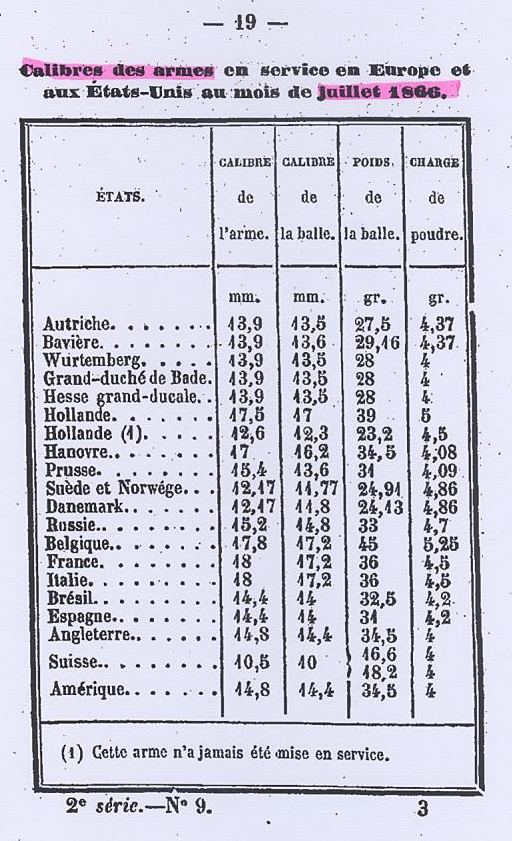
It is a period of strong technical evolutions, many choices exist. We make selection tests with a retrograde rifle but still strongly anchored in the minds: the shotgun. The latter is ultimately a stallion of the old armament and an old way of making war. On the other hand, no weapon with metal case is present on the ranks. The commission is charged with deciding on three weapons: the Chassepot rifle, the Chassepot rifle modified by Mr Plumerel, a rifle charging by the mouth. The Chassepot rifle was adopted.
The creator of the 1866 rifle is the author of three patents: the rubber shutter, the latch mechanism derived from the Prussian Dreysse, the cartridge. The ballistic characteristics of the gun and the warhead: bullet length / caliber, bullet weight / powder charge, shape and inclination of the stripes / influence of the rotation of the projectile were defined according to the studies of various stakeholders and commissions then applied on the Chassepot mechanism.
February 14, 1866, an order of 1500 weapons is passed to the factory of Châtellerault.
In June 1866, 400 rifles were received. they will be sent to the camp of Chalons to be experienced by the Imperial Guard (see first article on the Chassepot rifle).
July 03, 1866, creation of the manufactures of St Etienne and Puteaux. The goal is to manufacture 150,000 weapons a year and 1,800 machine tools for manufacturing.
The 1866 rifle is a resolutely modern weapon for its time. Terribly well done and that required a major effort to the nation. Then comes the time of the first tests then the fire test. The only criterion of the gun is not enough to predict the winner of future battles. The idyllic setting described by the first article has it evolved? What about the best weapon in Europe? Are Mr. Chassepot’s patents adapted to a weapon of war? or a stand gun?
Spitting towards the face of the shooter (synonymous with lack of tightness) are the reasons for the delay in the adoption and spread of bolt loading weapons. Mr Chassepot uses a recent material for the time: a rubber washer to achieve this seal which in the process reduces the recoil of the weapon. The room is deteriorating in various ways. It cracks, it melts and closes the channel of the needle, it loses its elasticity. The spitting increases in a growing way when in melting it loses its diameter. The soldier has a spare room in his cabin. The use of this material is a bold choice. To date, very few weapons have used rubber for this function. The Chassepot may be the only one.
As seen above, the seal is more or less well done to the outside. It is the same towards the interior. The gases, the result of the burning of the powder, go wherever they do not encounter resistance. This is how they pass into the breech through the channel of the percussion needle. This has the effect of soaking the percussion spring causing a weak percussion see the breakage of the spring. In some cases, it is possible to arm the dog just by slamming the ground diaper. The combustion gases also strongly foul the inside of the cylinder head.
The fouling does not only affect the inside of the cylinder head but also the room. Debris and firing residues remain and prevent the introduction of the following ammunition.
The diameter of the needle is 1.5 mm. A doubled diameter, 3 mm, would bring a solidity 4 times higher.
The muscled closure of the breech may cause the percussion of a cartridge. This sudden closure exists due to the lack of inclined closure ramp on the receiver. The presence of this machining helps the shooter to gradually push the ammunition into the chamber while locking the bolt. The vast majority of modern lock weapons have this ramp, it brings unparalleled comfort.
The polished white finish of the weapon, in addition to being very visible, requires significant maintenance under penalty of corrosion.
Despite the speech of Mr Thier, President of the Republic, of June 8, 1872:
“In the opinion of the men of war, the Chassepot rifle was the best weapon in use in the armies” “The Chassepot rifle is recognized excellent except the cartridge, which all European countries seek to improve” …
Although it is necessary to bear in mind the industrial context of the time as well as the speed with which the weapon was manufactured and distributed, it still seems that one can address some reproaches on the design of the Chassepot rifle.
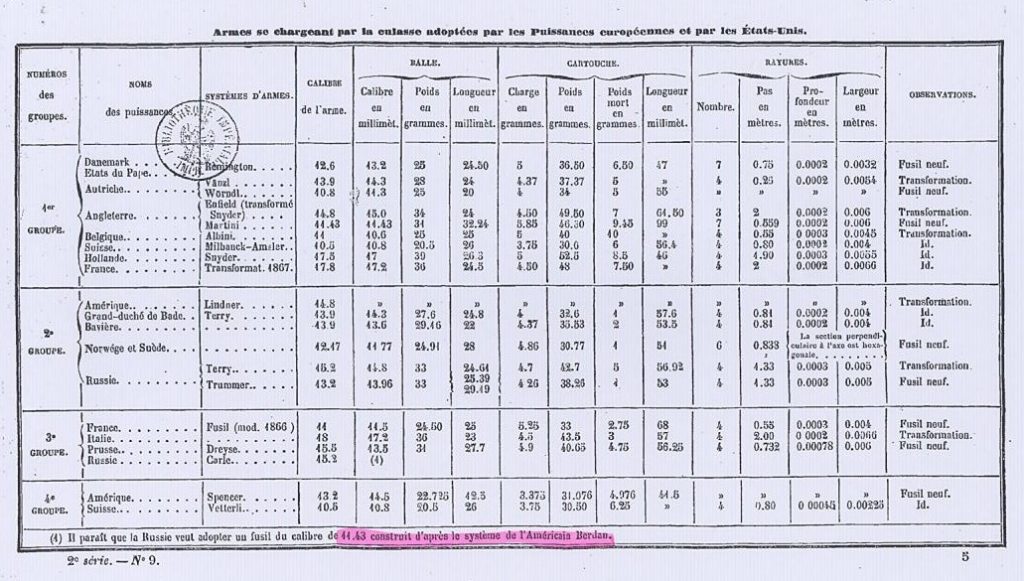
The Chassepot Rifle Cartridge
As said before, three principles compete at this time in the history of armament: the loading by the mouth, the cartridge with fuel pouch, the cartridge with metal case. Although proposed by the commission of Versailles, the loading by the mouth is considered exceeded, swept away by the consequences of the battles of Sadowa.
The fuel cell cartridge thus found itself in competition with the cartridge with metal case. Although some observers of the time give their preference for the latter which is said to be of better quality even from abroad. The disadvantages of it have had a bigger forum. The defects of the era of the metal cartridges are:
-
The excess weight of the holster. The weight of the case add to that of the warhead decreases the number of cartridges that can carry the soldier;
- Chemical reactivity between the holster and the powder which may lead to the decomposition of the powder;
- Delicate extraction;
- Cases that are likely to split;
- Requires the use of extractor. A thin piece, so fragile, not easy to replace by the fighter on the battlefield;
- The cartridge can not be recharged or manufactured by the fighter;
- The tools required for mass production are considered too expensive;
- The dimensional differences of cases due to various manufacturers;
- Lack of power of the ammunition;
- Difficulty of chambering in case of shocks on the case;
- The cost of manufacturing the case.
In 1866, no metal holsters were in competition with the Chassepot.
In 1873, the choice between modernity (cartridge with metal case) and semi-modernity (cartridge with combustible case) is not made. Public finances, past military principles have made some people say that the paper cartridge remains the future. The choice will be decided in 1874. This is probably the time needed to perfect the metal case and the time to overcome a certain resistance to changes.
The standard cartouche of the Chassepot
The characteristics of the regulatory cartridge are:
- Powder charge: 5.25 grams;
- Ball weight: 24.5 grams;
- A 25 mm long bale (should approach 33 mm for greater accuracy, 3 times the diameter);
- Diameter of the warhead: 11 mm.
According to the notice on cartridges for weapons of war and in particular for Chassepot rifle (1873), the 5 qualities of a weapon cartridge of war should be:
- 1 The preservation of the cartridge;
- 2 Regularity, promptness, security, accuracy of shooting;
- 3 The strength of the cartridge;
- 4 The ease of manufacture;
- 5 The economy over the cost price.
1 Cartridge conservation
We have a little trouble imagining a good and long conservation of paper ammunition loaded with black powder. In addition, what conservation are we talking about? those of the components before manufacture, conservation of the manufactured ammunition, conservation during the delivery, conservation in ammunition hold, conservation during the operational transports, conservation in the bags of the soldiers … Each of the manipulations quoted can be, if it is badly carried out, a source of deterioration. The ammunition with combustible case is fragile, they must be protected from the difficult atmospheric conditions … not easy in so much of war. The Chassepot cartridge is not ideal in this area.
2 Regularity
This quality comes from the homogeneity of a batch of cartridges. It therefore depends on a number of criteria such as conservation, regularity of components, manufacturing … to say that the parameters to master are important especially if part of the manufacturing is delegated to civilian workshops. To this must be added the irregular deposits left by the firing residues and the paper case in the room that will distort the regularity.
2 Readiness
The speed of the Chassepot shotgun is a real advantage compared to a weapon loading by the mouth and this especially as it allows a reload squatting or lying. This speed is only possible if the chamber of the weapon is not too dirty or if the warhead has not detached from the holster in the sack of the soldier … among others.
2 Security
It is a natural way that the Chassepot cartridge does not offer all the security guarantees. The reason has already been mentioned above: there can be no security when firing an ammunition without a case if the mechanism to load the bolt is not waterproof.
2 The accuracy of the shot
Some criteria of the accuracy of the shot are the centering of the ball on the axis of the barrel, the regularity of the speed of the bullet, the wear and the cleanliness of the barrel, the regularity of the weight and the diameter of the ogive.
Matching the axis of the bullet with the axis of the barrel while the chamber is fouled may seem complicated. Similarly in the case of a residue-free chamber, there is always a gap between the connecting cone and the warhead causing misalignment. This game can be decreased (but not removed) by using several layers of paper around the warhead, it will always result in a settlement and an irregularity.
Depending on the state of the rubber ring of the cylinder head, there may be losses of gas that change the internal pressure and therefore the speed of the warhead. This will have an influence on the projectile’s tension and thus on the accuracy of the shot. The firing residues present in the stripe of the barrel will have the same impact.
3 The strength of the cartridge
The solidity of the Chassepot cartridge is very inadequate for a war cartridge. It is estimated that 20 percent of the ammunition was damaged during the 1870-1871 conflict, sometimes destroyed in the military bag during travel. There are traces of stories of soldiers fleeing the enemy for lack of cartridges, for lack of supplies that do not come … even with the railroad.
4 The ease of manufacture
By adopting the cartridge paper case, we would like to keep the soldier the ability to make his own cartridges. In the case of taking a convoy, an enemy camp, it is then possible for the combatants to use the stocks of powder and primers left by the opponent.
Nevertheless ammunition becomes more complex, it is not so easy to have them manufactured by the soldiers in a war of advantage in movement. We rely on the use of the railroad to carry supplies. This is the beginning of “industrial operational support”. On the other hand, it is easy to set up manufacturing workshops with trained workers and simple tools. It appears that poor ammunition was delivered by civilian workshops during the 1870-1871 conflict. A worker makes 85 cartridges for every ten hours.
Following the modification of the military uses and the lengthening of the range of the weapons the consumption in ammunition explodes. This is probably one of the reasons for the lack of supply.
5 The economy
In 1873, a military law programs 1,200,000 men under the flag. At a rate of 100 cartridges per staff per year, an annual requirement of 120,000,000 cartridges are required under penalty of insufficient instruction. It is easy to imagine that each component needs to be optimized in order to reduce the cost as much as possible and thus reduce the bill. In view of the annual need for cartridges, the smallest savings passed on each munition represents very quickly large sums. The paper case cartridge remains more economical than the metal case cartridge.
Can we say that 100 cartridges a year are enough to educate and maintain the knowledge of a shooter, a soldier? We then see the interest of encouraging private initiatives such as the establishment of civilian firing ranges, hunting societies, to educate children shooting at school, to propose weapons close to regulatory weapons to civilians so that they train throughout the year without impacting the resources of the state. We find in the old catalogs of manufactures the traces of these initiatives.
Many of the above criteria are not met, however, the paper cartridge will be accepted.
The Callebaut cartridge
“The Chassepot rifle is recognized as excellent except the cartridge, which all European countries are seeking to improve.” (speech of the President of the Republic June 8, 1872)
In a desire to equip the Chassepot rifle with a more adequate ammunition. The house Callebaut (Paris) offers a cartridge with wooden body. This new cartridge without a metal case is said to hunt hunted.
This consumable case cartridge version provides a faster shot of 150 cartridges for only 101 cartridges fired with the prescribed ammunition. One miss on 1089 rounds fired. 207 cartridges shot without incident related to the rubber sealing system against 85 in the regulatory rifle thanks to the use of a rubber membrane closing the tube of the cartridge and which under the pressure of the gas vein take a larger diameter (decreasing the stresses on the rubber shutter).
When fired, the wooden tube 13.5 mm in diameter is forced into the cone of connection, which breaks it and the pieces of wood leaving the barrel cleans the latter. No plots of wood stay in the room.
The wooden body of the cartridge is stronger than that of the standard cartridge. According to the manufacturer, it can be half-crushed, the ammunition still works. If it still works … it must be difficult to chamber !!
200 cartridges can be manufactured in ten hours, or 2.35 times more than for the prescribed ammunition. Time is not the only one to be saved, the missed ammunition is too.
This cartridge does not seem to have been adopted by the armies. The following year, the Gras rifle will end the paper cartridge case, the era of the metal case has arrived.
I did not find any representation of this ammunition.
Conclusion
We can see through this series of articles the difference between the transcription of the book and the reality of war, finally … between theory and practice.
Pressed by German victories, including that of July 3, 1866 in Sadowa, France decided hastily to equip his army. She chose a modern weapon for the time: the 1866 Chassepot rifle. It takes the opportunity to create new factories. The choice made by France is audacious. Modern engineers have not clearly solved and therefore not or little commercialized this type of weapon. Indeed, the use of fuel cases is likely to face problems that are difficult to solve today. In particular the clogging of the chamber and the sealing. It is ambitious in 1865-1866 to want to replace a regulatory piston weapon with a weapon adding several technical advances with the hope of solving major problems (use of a mechanism to load by the cylinder head, reduction of the caliber, fouling of black powder, fouling of residues of burned paper, evolution of the doctrine of the use of long weapons, adoption of new ammunition, mass production of the new ammunition, use of an uncommon material then in armory: rubber, etc …) all made by a new factory.
The St Etienne gun factory will supply the weapons ordered shortly before the war, but what about the training of soldiers, officers, health services, various supplies …
Germany took the lead in endowing its army with breech-loading rifles well before other nations (1841, 25 years before France). This advance certainly had setbacks but by equipping decades before the others, they had time to stop at various technical events and train their soldiers, gunsmiths, officers to make them more fit to fight.
Following the despatch of Ems and despite the warnings of Adolphe Thier, France declared war on Germany. The war lasted from July 19, 1870 to January 29, 1871, a little over six months. The result of the lack of preparation will be the loss of Alsace-Lorraine. Territory that will remain German until the end of the world premiere is 47 years.
Fundamental problems directly affecting Mr Chassepot’s patents would have been worthy of experience earlier, which would have allowed the various levels of civilian and military maintenance and supply to address certain pre-conflict defects. Or, do not declare war on Germany to fix the anomalies. Chassepot rifles will be transformed from 1874 for firing the metal cartridge. It will bear the name of 1866/74 Bold.
In 1873, America, England, Belgium adopted metal cartridge weapons. France is resisting, the cause is perhaps the absence, the limitation of private industries that bring, in the hope of a major government contract, an innovation, a competition more abundant. France preferred the opposite: the monopoly of national manufactures whose insufficiency, history demonstrated it during the war of 1870-1871 and many years later (to see article gunsmith designer concerning revolver 1892) , can occur.
The importance of regimental gunsmiths and private companies to change the world of weapons, quickly change endowment weapons is well established. A nation must maintain knowledge and talents. To date, the situation of the arms industry in France is such that the private industry dies, the manufacture of weapon of St Etienne is closed, the next assault rifle of the French army will be German and American inspired.
Useful sources for writing this article:
You can download these three documents on the download page of the site:
- Armament of Europe and the United States: Influence of the Rapid Shooting Rifle on Tactics and Training of the Soldier – 1870 – (bnf-Gallica);
- Small arms and the treatment of firearm wounds in the field – 1892 – (bnf-Gallica);
- Notice on the cartridges for weapons of war and in particular on the cartouche for rifle Chassepot – 1866 – (bnf-Gallica).








